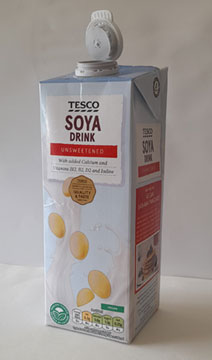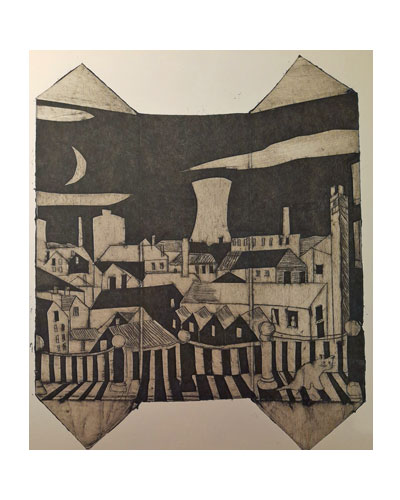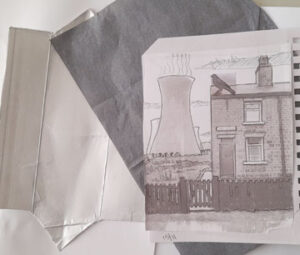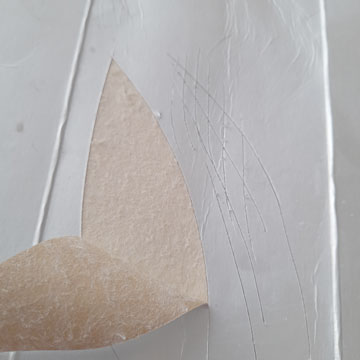What is Tetra Pak printmaking?
And… how do you go from the carton on the left to the print on the right?
See instructions below for the whole process for using a Tetra Pak carton. It has a metallic interior surface that can be used as a printmaking plate. The metallic surface can be cut and removed or lines can be created with a drypoint tool.
Tetrapak carton and the resulting print


First: Wash the carton and then cut the carton open at the back on the seam, carefully so as not to damage the fairly fragile inner surface. Flatten the carton under weights overnight.
Transferring a drawing: To do a drawing on the plate, you can draw directly with the drypoint needle, or a nail or any sharp pointed instrument, or you can use carbon paper to transfer a drawing onto the plate for accuracy, which is what I did in my print above.


Tools: Use a drypoint needle, rather than a sharper etching needle. This is to create lines, outline shapes and cross hatching. In order to create dark areas you need to cut away the shape with a scalpel. The top will peel off and leave a soft underlay which will pick up lots of ink and create tonal areas. Which can be seen in the print above.
Printing: To print your plate you need a soaking bath and good thick paper; I use Hahnemulle or Somerset, at least 280gsm; soak the paper for 30 mins and blot fairly dry. Hand printing does not work for these prints; it won’t show the fine lines or create an even print. You do need access to an etching press. Print as you would an etching, get the pressure right on the press. Lay the soaked and dampened paper on top of the plate and run it through the press. Let it dry under tissue paper and boards for a day or so to dry properly.
Inking the Plate: I use soft Akua printing inks rather than the normal etching ink which is too heavy and sticky for this fragile surface. Apply the ink over the whole plate using a dabber or a piece of card. Making sure you get ink into all the fine lines. Then remove as much ink as you can with soft tarletan or scrim, then use phone book paper/newsprint and afterwards, tissue paper to get a good plate tone. You can use cotton buds to pick out highlights.
Warning: Tetrapak is not recommended for long editions as it is fragile and needs to be printed with care. For longer editions I use Enviromount, this is a laminated card which works in the same way as Tetra Pak, whereby you can cut away areas and get nice dark areas. You would not get this even dark area using perspex.
Tips: You can cut the material into shapes and print those, or stick shapes together using strong tape on the back to make larger shapes.
Chine Colle: during the printing process you can apply lightweight tissue or japanese paper which glue on the top, in order to achieve colour layers.
UK Suppliers of drypoint media and paper: Handprinted in the UK and also Intaglio Printmakers in London.
Gandha Key, 2025
